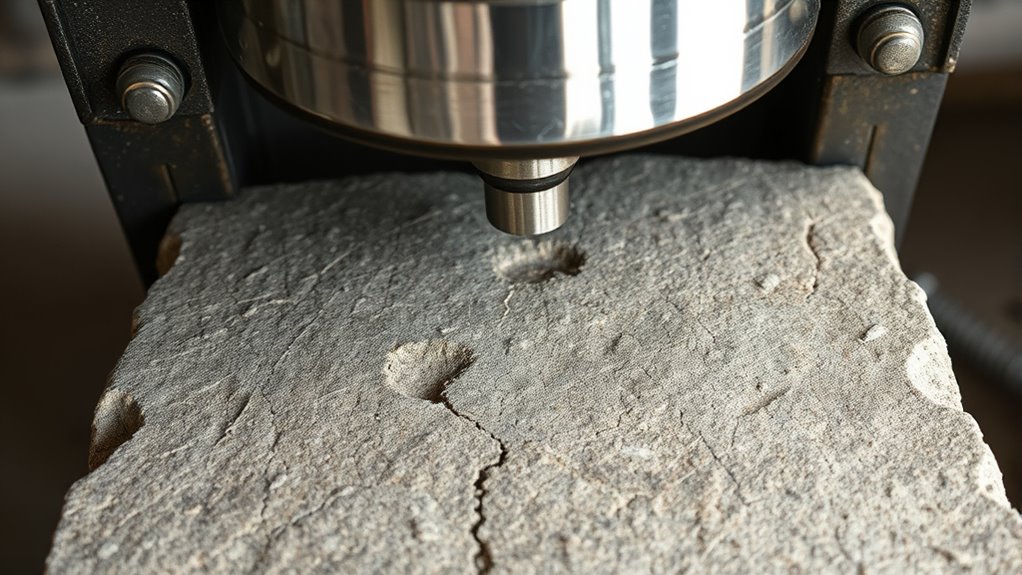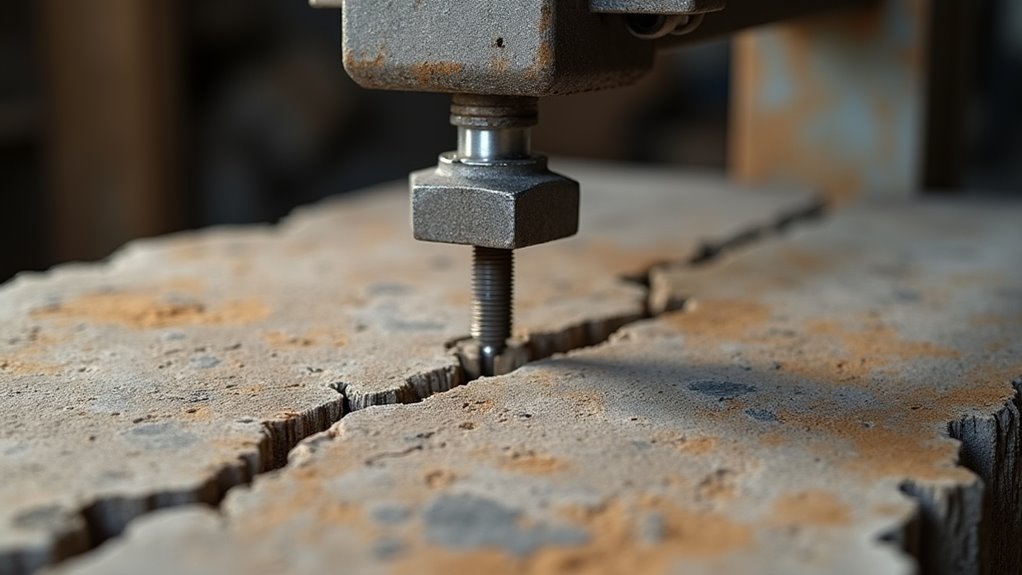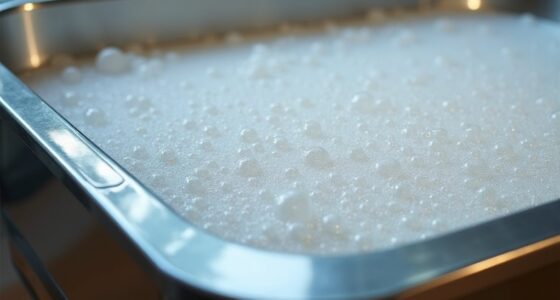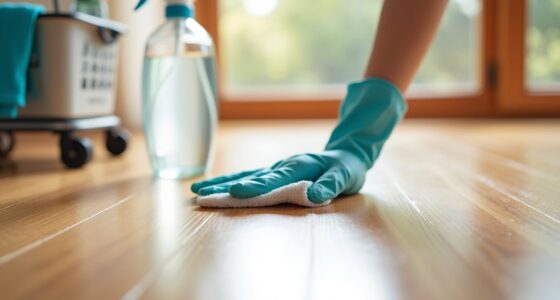Applying too much downward pressure on natural stone can cause cracks, chips, or surface damage, especially if the stone isn’t properly sealed or is weaker. To avoid harm, respect the stone’s weight capacity, which varies depending on its type and condition. Gentle, evenly distributed pressure helps maintain the stone’s strength and appearance. Want to find out the exact limits and how to protect your stone? Keep exploring for essential tips.
Key Takeaways
- Natural stones vary in strength; consult manufacturer guidelines or professionals to determine specific weight limits.
- Proper sealing and maintenance help distribute pressure evenly and prevent damage from excessive weight.
- Avoid placing heavy objects directly on stone surfaces without verifying their load capacity.
- Use soft, non-abrasive cleaning methods to prevent surface weakening that could reduce load tolerance.
- Regular inspections and professional assessments ensure weight limits are respected and prevent microfractures.

Have you ever wondered how natural stone withstands heavy loads and daily wear? It might seem tough, but without proper care and maintenance, even the strongest stone can suffer damage over time. One of the key factors in preserving natural stone’s integrity is understanding the impact of down pressure—how much weight it can safely bear without cracking or chipping. Knowing this helps prevent costly repairs and preserves the stone’s beauty and functionality for years to come.
Understanding down pressure helps protect natural stone from damage and prolongs its lifespan.
When it comes to managing down pressure, sealing techniques play a significant role. Applying the right sealant creates a protective barrier that reduces the penetration of moisture, oils, and other substances that can weaken the stone’s structure. Proper sealing also helps distribute weight more evenly across the surface, reducing stress points that could lead to fractures. It’s essential to choose a sealant suited for your specific type of natural stone and to reapply it periodically, following the manufacturer’s instructions. This ongoing maintenance minimizes the risk of damage caused by excessive pressure or accidental impacts.
Alongside sealing, using appropriate cleaning methods is crucial to maintaining the stone’s strength. Harsh chemicals, abrasive scrubbers, or overly aggressive cleaning can erode the surface, making it more susceptible to damage under pressure. Instead, opt for gentle cleaning solutions and soft cloths or mops that won’t scratch or weaken the stone. Regular cleaning removes debris and dirt that can trap moisture or create uneven surfaces, which might concentrate stress under heavy loads. Additionally, avoid placing extremely heavy objects directly on the stone unless you’re certain it’s designed to handle such weight. For instance, placing a heavy piece of furniture or equipment on a fragile or improperly sealed surface can cause microfractures over time.
Understanding the importance of proper sealing techniques and cleaning methods helps you gauge how much down pressure your natural stone can handle. Always consider the type of stone and its specific properties—granite, marble, limestone—all have different strengths and vulnerabilities. When in doubt, consult with professionals who can assess your stone’s condition and recommend suitable maintenance routines. Remember, prevention is better than repair; taking proactive steps today ensures your natural stone remains durable and stunning for years. By respecting its limits and caring for it carefully, you’ll extend its lifespan and enjoy its beauty without worrying about damage caused by excessive pressure. Additionally, understanding the weight capacity of natural stone can guide you in making informed decisions about its use in your space.
Frequently Asked Questions
Can Natural Stone Withstand Extreme Weather Conditions?
Natural stone can withstand extreme weather conditions if it’s properly selected and treated. You should look for stones with high weather resistance to guarantee your stone surface stays durable. While some natural stones like granite or basalt handle freezing temperatures and heavy rain well, others may require sealing or additional maintenance. Always consider your local climate and choose a stone that’s proven to endure the specific weather challenges in your area.
How Does Down Pressure Affect Natural Stone During Installation?
During installation, down pressure impacts natural stone by increasing stone compression, which can cause cracks or damage if excessive. You should carefully control down pressure using proper installation techniques to avoid overstressing the stone. Applying consistent, moderate pressure ensures the stone bonds well without risking structural integrity. Always follow manufacturer guidelines and use proper tools, as improper down pressure can compromise the durability and aesthetic of your natural stone installation.
Are There Specific Natural Stones More Resistant to High Pressure?
Imagine a fortress standing firm against relentless storms—that’s what some natural stones do with pressure resistance. Stones like granite and basalt boast impressive stone strength, making them more resistant to high pressure. These durable materials can handle the force of installation better than softer stones like marble or limestone. If you seek resilience, opt for these robust options, ensuring your project withstands the tests of time and pressure.
What Are Signs of Damage From Excessive Down Pressure?
You’ll notice damage from excessive down pressure as your stone surface develops cracks, chips, or uneven spots. The structural integrity weakens, making the surface more prone to further damage. You might also see discoloration or surface spalling, which indicate stress. If you observe these signs, it’s essential to reduce pressure immediately to preserve the stone’s strength and prevent costly repairs. Proper handling protects both the surface and its long-term durability.
How Can I Test Stone Durability Against Down Pressure?
Did you know that stress testing natural stone can reveal its material resilience, helping prevent damage? To test durability against down pressure, gradually apply weight using calibrated equipment, monitoring for cracks or deformation. This controlled approach allows you to assess how much stress the stone can withstand without failure. Regular stress testing guarantees your natural stone maintains its strength and longevity, giving you confidence in its performance under load.
Conclusion
Remember, too much down pressure on natural stone is like squeezing a sponge—eventually, it’ll break down. You want to apply enough force to get the job done without damaging the delicate surface beneath. Think of it as walking a tightrope: balance is key. By understanding the right amount of pressure, you’ll preserve the stone’s beauty and strength, ensuring it stays stunning and durable for years to come.









